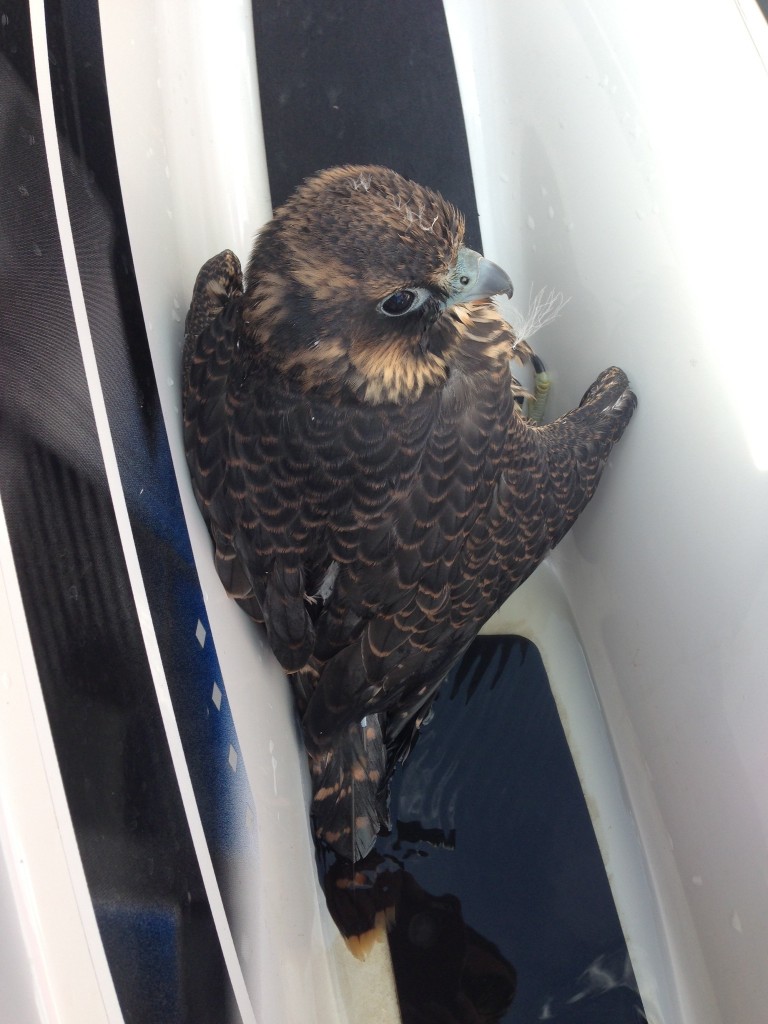Peregrine Falcon Rescue
August 13, 2014A baby peregrine falcon sits in the footwell of a Jet Ski after being rescued from the Illinois River by a Peoria nurse. Photo Courtesy of Terra Hutchinson.
by Elise Zwicky
When Terra Hutchinson set out on a Jet Ski with her 8-year-old daughter and another child July 4, she never imagined she’d end up rescuing a rare baby falcon in the Illinois River.
“I didn’t know it was a falcon or even that it was a baby. I just knew it was a bird, and it was struggling in the water,” said Hutchinson, a nurse. “Her wing span was about 2 ½-feet wide, and she kept flapping her wings like she was trying to take off.”
Estimated to be about 45 days old, the female peregrine falcon is now in the care of Jim Robison of Hopedale, a longtime falconer and wildfowl sculptor. Robison built a nest box for peregrine falcons about six years ago on the Associated Bank building in downtown Peoria.
The falcons use the nest most of the year except during breeding season, when they seem to be drawn to the underside of the McClugage Bridge.
“My guess is these adult birds probably fledged from a bridge somewhere, so they’re actually imprinted on bridges, and there’s not much we can do to lure them away from there,” Robison said.
Robison and wildlife rehabilitator Marge Bjorklund, who Terra Hutchison first called after rescuing the bird, both shudder to think how many baby falcons have drowned in the river.
“As the babies come out of the nest for the first time, they don’t have much strength and they fall into the water,” Robison explained. “I’ve spent a lot of time in downtown Peoria watching the peregrines and have yet to see an immature peregrine this time of year, which means the babies did not live.”
Robison gave kudos to Hutchinson for fishing the falcon out of the water, but Hutchinson said she had no choice.
“I looked at that bird, and she kept looking at me, and there was a barge coming and other boats. There was no possible way I could just leave it there,” she said.
Jim Robison, a longtime falconer and well-known wildfowl sculptor, adjusts a sculpture he created on the wall of his studio in Hopedale. Photo Courtesy of Elise Zwicky.
Hutchison scooped the bird up with her hand and placed it in the footwell of the Jet Ski, then headed back to Eastport Marina. A small crowd gathered when Hutchinson announced she had a bird that needed help. Someone offered a small dog crate to put the bird in, which is the first time Hutchinson noticed her large feet and talons.
Robison said, “Baby hawks look intimidating, but realistically they’re not that strong or powerful. But an adult can put the hurts on you something bad. If you find one, you just want to get a hold of the right people ASAP.”
Initial calls to the Peoria Zoo and Farmdale Park yielded no help, but Wildlife Prairie Park provided Bjorklund’s number, and she instructed Hutchinson to get the bird to Robison. Unfortunately, Robison was out of state, so Tazewell Animal Control took the bird and placed it with another wildlife rehabilitator until he returned several days later.
Robison now has the falcon–which Hutchinson’s daughters named Freedom–in a large flight aviary with baby gyrfalcons he raises. Time will tell if the stress and shock the bird has suffered caused permanent damage to her feathers.
“In the wild, these birds dive up to 200 miles an hour to catch their prey, so we’re in a wait-and-see mode until her feathers grow all the way out, and then she’ll go into training to learn how to hunt,” he said.
If he determines the bird can’t survive on her own in the wild, she’ll find a home in an educational program. Either way, Hutchinson has given her a chance to live.
Robison said he cared for another fledgling peregrine falcon rescued from the river several years ago that he was able to release back into the wild. He and Bjorklund are asking boaters to watch for baby falcons near the McClugage Bridge. He’d also like to set up another nest box closer to the bridge if he can find a business near there willing to help.
“Peregrine falcons are one of the fastest animals on the earth, and here it is right under everyone’s nose,” Robison said. “Most people don’t get to see it because it moves so fast, but when you do get to see it, it’s pretty stinking cool.”









